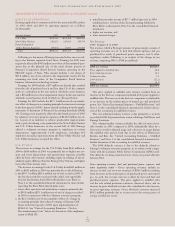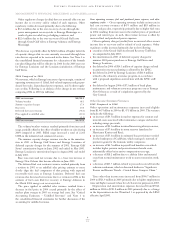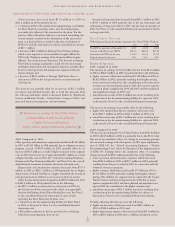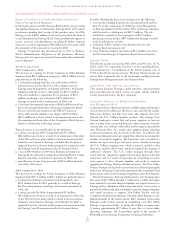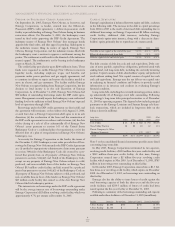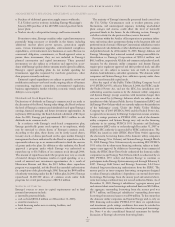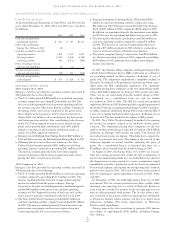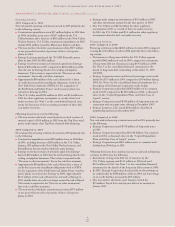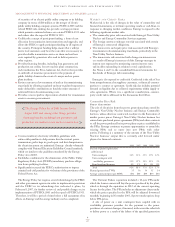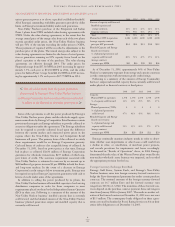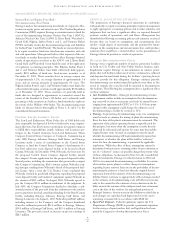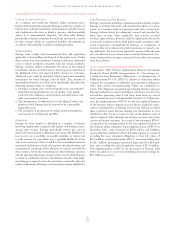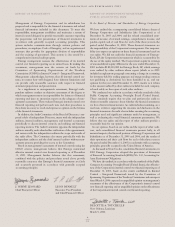Entergy 2005 Annual Report Download - page 48
Download and view the complete annual report
Please find page 48 of the 2005 Entergy annual report below. You can navigate through the pages in the report by either clicking on the pages listed below, or by using the keyword search tool below to find specific information within the annual report.
ENTERGY CORPORATION AND SUBSIDIARIES 2005
*
44
FEDERAL REGULATION
The FERC regulates wholesale rates (including Entergy intrasystem
sales pursuant to the System Agreement) and interstate transmission
of electricity, as well as rates for System Energy’s sales of capacity
and energy from Grand Gulf to Entergy Arkansas, Entergy
Louisiana, Entergy Mississippi, and Entergy New Orleans pursuant
to the Unit Power Sales Agreement.
System Agreement Proceedings
The domestic utility companies historically have engaged in the
coordinated planning, construction, and operation of generating
and bulk transmission facilities under the terms of the System
Agreement, which is a rate schedule that has been approved by the
FERC. The LPSC pursued litigation involving the System
Agreement at the FERC. The proceeding includes challenges to the
allocation of costs as defined by the System Agreement and raises
questions of imprudence by the domestic utility companies in their
execution of the System Agreement.
In June 2005, the FERC issued a decision in the System
Agreement litigation, and essentially affirmed its decision in a
December 2005 order on rehearing. The FERC decision concluded,
among other things, that:
■The System Agreement no longer roughly equalizes total
production costs among the domestic utility companies.
■In order to reach rough production cost equalization, the FERC
will impose a bandwidth remedy by which each company’s total
annual production costs would have to be within +/- 11% of
Entergy System average total annual production costs.
■When calculating the production costs for this purpose, output
from the Vidalia hydroelectric power plant will not reflect the
actual Vidalia price for that year but will be priced at that year’s
average price for the exchange of electric energy among the
domestic utility companies under the System Agreement, thereby
reducing the amount of Vidalia costs reflected in the comparison
of the domestic utility companies’ total production costs.
■The remedy ordered by FERC calls for no refunds and would
be effective based on the calendar year 2006 production costs
with the first potential reallocation payments, if required, to be
made in 2007.
The FERC’s decision would reallocate total production costs of
the domestic utility companies whose relative total production costs
expressed as a percentage of Entergy System average production
costs are outside an upper or lower bandwidth. This would be
accomplished by payments from domestic utility companies
whose production costs are more than 11% below Entergy System
average production costs to domestic utility companies whose pro-
duction costs are more than 11% above Entergy System average
production costs.
An assessment of the potential effects of the FERC’s decision
requires assumptions regarding the future total production cost of
each domestic utility company, which assumptions include the mix
of solid fuel and gas-fired generation available to each company and
the costs of natural gas and purchased power. Entergy Louisiana,
Entergy Gulf States, and Entergy Mississippi are more dependent
upon gas-fired generation sources than Entergy Arkansas or
Entergy New Orleans. Of these, Entergy Arkansas is the least
dependent upon gas-fired generation sources. Therefore, increases in
natural gas prices likely will increase the amount by which Entergy
Arkansas’ total production costs are below the average total produc-
tion costs of the domestic utility companies.
Considerable uncertainty exists regarding future gas prices.
Annual average Henry Hub gas prices (daily midpoint prices
sourced from Platts Gas Daily) have varied significantly over recent
years, ranging from $2.007/mmBtu to $8.529/mmBtu for the 1996-
2005 period, and averaging $4.098/mmBtu during the ten-year
period 1996-2005 and $5.434/mmBtu during the five-year period
2001-2005. Recent market conditions have resulted in gas prices
that averaged $8.529/mmBtu for the twelve months ended
December 2005. During the twelve-month period January 1, 2005
to December 31, 2005 forward gas contracts for each of the next
four years based on daily NYMEX close averaged $8.74/mmBtu
(2006), $7.95/mmBtu (2007), $7.32/mmBtu (2008), and $6.83/mmBtu
(2009). If, after pending appeals, the FERC’s decision becomes final
and if gas prices occur similar to the NYMEX average closing
prices given, the following potential annual total production cost
reallocations among the domestic utility companies could result
(in millions):
Range of Annual Payments Average Annual Payment
or (Receipts) or (Receipts)
Entergy Arkansas $ 293 to $ 385 $ 328
Entergy Gulf States $(264) to $ (196) $(230)
Entergy Louisiana $ (96) to $ (51) $ (77)
Entergy Mississippi $ (31) to $ (3) $ (21)
Entergy New Orleans $ 0 $ 0
If natural gas prices deviate by $1/mmBtu up or down from the
NYMEX average closing prices given above, it is expected that
Entergy Arkansas’ annual payments will change in the same direc-
tion by approximately $70 to $80 million.
The LPSC, APSC, MPSC, and the Arkansas Electric Energy
Consumers (AEEC) have appealed the FERC decision to the Court
of Appeals for the D.C. Circuit. Entergy has intervened in the
LPSC appeal and intends to intervene in the other appeals. The
City of New Orleans has also intervened in the LPSC appeal.
Entergy will be required to file with the FERC a compliance
filing to implement the provisions of the FERC’s decision.
Management believes that any changes in the allocation of produc-
tion costs resulting from the FERC’s decision and related retail
proceedings should result in similar rate changes for retail cus-
tomers. The timing of recovery of these costs in rates could be the
subject of additional proceedings before Entergy’s retail regulators.
Although the outcome and timing of the FERC and other proceed-
ings cannot be predicted at this time, Entergy does not believe that
the ultimate resolution of these proceedings will have a material
effect on its financial condition or results of operations.
MANAGEMENT’S FINANCIAL DISCUSSION and ANALYSIS continued
The FERC decision concluded, among other
things, that the System Agreement no longer
roughly equalizes total production costs
among the domestic utility companies.
<
>


